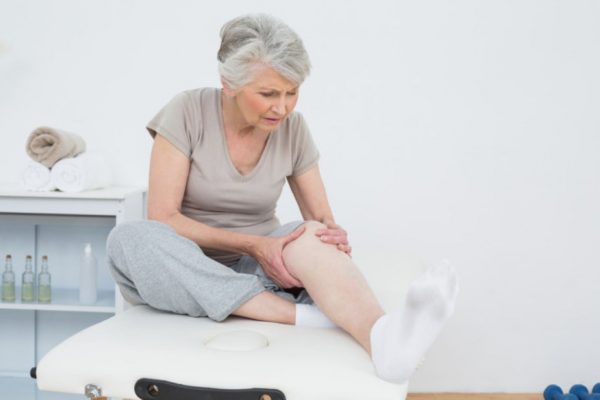People think arthritis only happens in old people. Ask any 40-year-old with arthritis, and they’ll tell you just how untrue that is. In fact, more than half of adults with arthritis are between the ages of 18 and 64.
The truth is that, even though we often call arthritis an age-related disease, it’s not actually caused by old age. Chronic inflammation, obesity, joint injury, diabetes, heart disease and all sorts of factors come in to play. It’s not just one thing. And it doesn’t care how old you are. You could be 15, 40, 60 or 90. You’re not immune.
So while a lot of people believe the “old-age” myth of arthritis, it’s just not true.
And there are a lot of other misconceptions about arthritis that sound pretty believable.
When I was a kid, I was told that cracking my knuckles would distort my fingers and give me arthritis when I got older. The adults believed it, and I believed them. But it turns out that just isn’t the case.
The only thing that happens when you crack your knuckles is a release of gas from the synovial fluid. This has not been shown to cause arthritis (although it could weaken your hand grip in later years if you’re a chronic knuckle-cracker).
What about nightshade vegetables? Do you have to avoid them if you have arthritis?
The real answer is probably not.
Nightshade foods contain solanine, which some people blame for the swelling, pain and stiffness associated with arthritis. But the amount of solanine found in nightshades is so miniscule that it’s unlikely that avoiding these foods would have any noticeable effect on your symptoms.
Some common nightshade vegetables include tomatoes, white potatoes, bell peppers, eggplant and red spices. These are all nutritious foods. Some protect against cancer. Some are powerful anti-inflammatories. Most are high in antioxidants. It would be a shame to eliminate them from your diet.
That being said, food sensitivities in some people can’t be ruled out. Generally, in that case, it’s not really a problem with the food, but a symptom of something else going on in the body.
Heat It, Ice It and Move It!
You’ll hear people tell you not to apply ice or a cold compress to a stiff, achy joint. The theory behind this advice is that the cold will make it seize up even further.
It might sound logical, but there is good reason to rotate between ice and heat for your arthritic joints.
One of the key elements to joint pain is inflammation. Ice reduces that inflammation and helps bring down the pain and swelling.
Heat, on the other hand, relaxes the muscles and lubricates the joint. This helps reduce stiffness and improves joint flexibility.
So I don’t recommend choosing one above the other. Use heat to loosen things up and use cold to reduce swelling. For example, before performing physical activities apply heat to reduce stiffness. Afterward, apply cold to relieve pain and swelling.
And speaking of physical activity, no, moderate exercise won’t wear your joints out more quickly. In fact, it might be your best medicine against arthritis.
This is truly one of those “use it or lose it” scenarios. The more inactive you are, the worse your arthritis will get – and the lower your physical function will become. Since arthritis is the most common cause of disability in U.S. adults, you want to avoid that at all costs.
But I know. Even the thought of walking around the block while you’re in pain sounds like tackling Mount Everest. And you probably think it will make your pain worse.
In the long run, it will actually help reduce pain and increase your flexibility. Any type of movement, no matter how small, can help. Walk, swim or try water aerobics. Ride a bike. Sign up for yoga, tai chi or Pilates.
Just talk to your doctor about it and get moving!
You CAN Do Something About Arthritis
While there isn’t a cure for arthritis, there are things you can do to prevent it or slow it down.
Don’t let yourself become obese. If you want to slow down the progression of arthritis or possibly avoid it altogether, then make sure you’re not obese. Excess fat contains inflammatory chemicals which cause oxidative stress on your body, a key factor in the development and progression of arthritis.
Keep moving. Honestly, I try not to use the word “exercise” anymore. If you can just do some sort of movement each and every day, you’ll be doing your body – and your joints – a world of good.
Eat the right foods. Finally, you should be careful about what you eat. Avoid foods that have been fried or processed and those that are salty, sugary and high in carbs.
Focus on antioxidant rich foods. Fruits and veggies from all colors of the rainbow – red, blue, purple and more. (You know my favorite, right? Blueberries! I love them.)
Nuts, olive oil, beans and wild caught fish are all rich in antioxidants, too.
SOURCES:
Arthritis in America. Centers for Disease Control and Prevention. Publication date: 03/07/2017.
Shane Anderson A, Loeser RF. Why is osteoarthritis an age-related disease? Best Pract Res Clin Rheumatol. 2010;24(1):15-26.
Clark R, Lee SH. Anticancer Properties of Capsaicin Against Human Cancer. Anticancer Res. 2016 Mar;36(3):837-43.
Rowles JL 3rd, Ranard KM, Applegate CC, Jeon S, An R, Erdman JW Jr. Processed and raw tomato consumption and risk of prostate cancer: a systematic review and dose-response meta-analysis. Prostate Cancer Prostatic Dis. 2018 Sep;21(3):319-336.
Zimmer AR, Leonardi B, Miron D, Schapoval E, Oliveira JR, Gosmann G. Antioxidant and anti-inflammatory properties of Capsicum baccatum: from traditional use to scientific approach. J Ethnopharmacol. 2012 Jan 6;139(1):228-33.
Hunter DJ, Eckstein F. Exercise and osteoarthritis. J Anat. 2009;214(2):197-207.
Lee J, Chang RW, Ehrlich-Jones L, Kwoh CK, Nevitt M, Semanik PA, Sharma L, Sohn MW, Song J, Dunlop DD. Sedentary behavior and physical function: objective evidence from the Osteoarthritis Initiative. Arthritis Care Res (Hoboken). 2015 Mar;67(3):366-73.
Zahan OM, Serban O, Gherman C, Fodor D. The evaluation of oxidative stress in osteoarthritis. Med Pharm Rep. 2020;93(1):12-22.
Liu Q, Hebert, JR, Shivappa N. et al. Inflammatory potential of diet and risk of incident knee osteoarthritis: a prospective cohort study. Arthritis Res Ther 22, 209 (2020).



